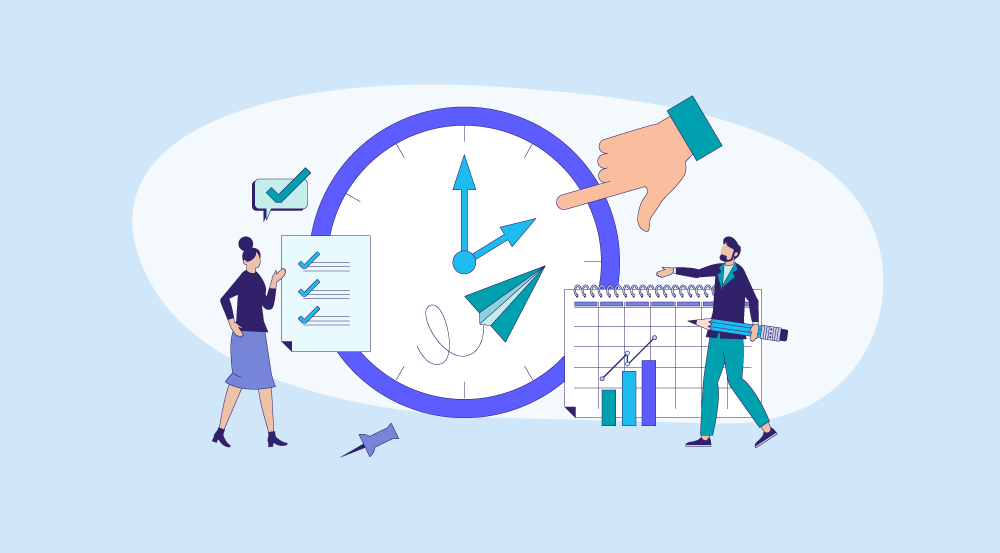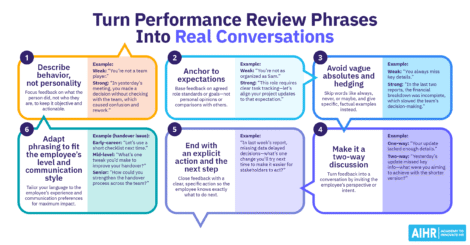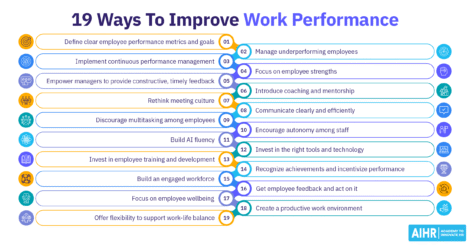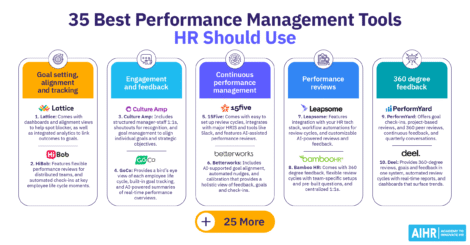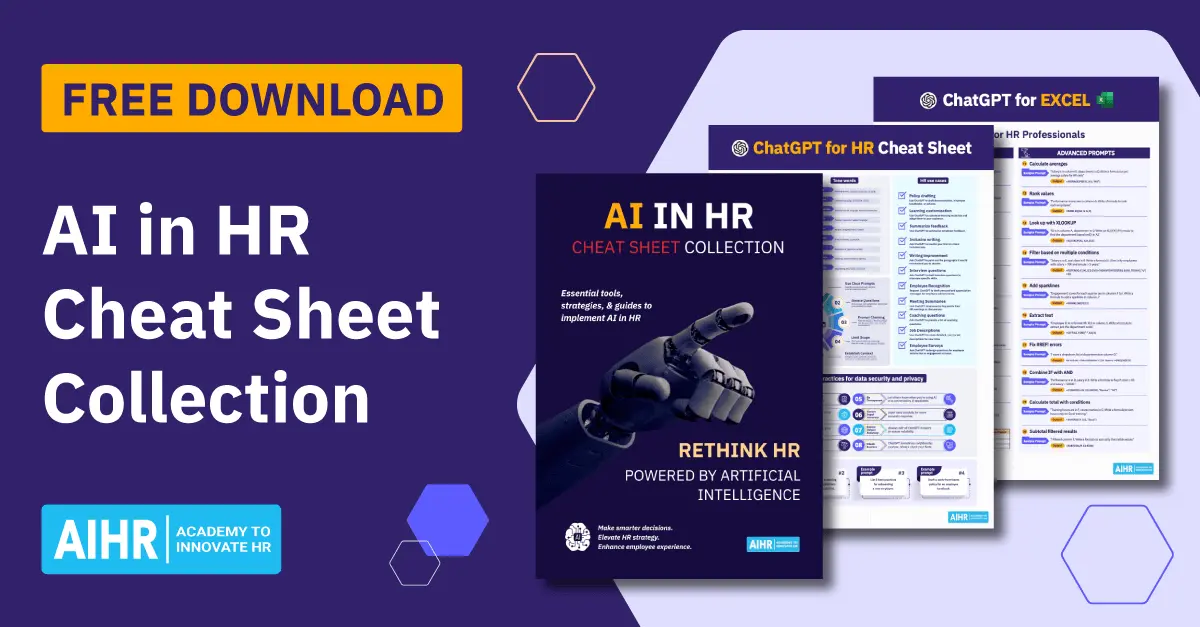Performance management helps align employees’ work with business goals, clarify expectations, and improve results over time. Performance management tools support this by organizing goals, check-ins and reviews in one place, making it easier to track progress, spot issues early, and measure performance with real-time data.
This article looks at 35 useful performance management tools and how you can use them to boost your company’s performance management cycle, how to choose the right one, and how to implement these tools to suit your organization’s needs.
Contents
The benefits of performance management tools
35 best performance management tools to consider
– Goal setting, alignment and tracking
– Engagement and feedback
– Continuous performance management
– Performance reviews
– 360-degree feedback
8 questions to ask when deciding on the right tool
Implementing performance management tools: Top HR tips
Key takeaways
- Modern performance management tools centralize goals, feedback, reviews and analytics, reducing admin work and enabling more objective, data-driven decisions.
- Choosing the right tool means checking alignment with business and HR goals, integration and scalability, customization, analytics, AI, compliance, and vendor support.
- Successful implementation depends on clear policies, strong stakeholder buy-in, focused manager enablement, and ongoing iteration based on user feedback and performance data.
- Making performance management continuous and people-centered builds trust, supports employee growth, and links everyday work to business outcomes more clearly.
The benefits of performance management tools
Performance management tools help streamline and standardize core people processes. They centralize goals, reviews, feedback, and performance data, saving time and reducing admin work.
They also offer better visibility into skills, performance trends and talent gaps, making it easier to support succession planning, learning and development (L&D), and fair, data-driven decisions on pay and promotions. At the same time, these tools help ensure compliance and consistency by applying the same frameworks and criteria to everyone.
For employees and the company, performance management tools create clarity, transparency and accountability. Employees know what’s expected of them, can track their progress in real time, and receive more frequent, structured feedback.
Managers can spot issues early, recognize good performance, and coach more effectively. This leads to better team and individual engagement, retention and performance, as well as the company hitting its strategic goals.
35 best performance management tools to consider
Below is a list of 35 tools for performance management you can consider, categorized according to the aspect of performance management they’re suitable for. Do note that despite the categories, some tools can also be useful for more than one area of performance management.
Goal setting, alignment and tracking
These performance management tools support goal setting, alignment and tracking by turning company strategy into clear, measurable goals. This makes misalignment visible early on, helping managers course-correct based on data rather than gut feel.
1. Lattice
- Pricing: $10 per seat per month (core HRIS), or $11 per seat per month (talent management foundations).
- Customer rating: 4.7/5 (≈4,000 reviews on G2).
- Suitable for: Small to enterprise organizations (broad fit, strong mid-market adoption).
Lattice is a performance and employee success platform that combines reviews, goals, engagement surveys, and growth plans.
Top features:
- Company → team → individual goals/OKRs with live progress in one-on-ones and reviews
- Goal dashboards and alignment views to spot blockers and drive focus
- Integrated performance reviews, feedback, and analytics to connect outcomes to goals.
2. HiBob
- Pricing: Available on request.
- Customer rating: 4.5/5 (≈2,000 reviews on G2).
- Suitable for: Mostly SMEs, but HiBob also offers solutions for larger organizations.
HiBob is a modern HRIS that centralizes core HR, people data, workflows and engagement in one system.
Top features:
- Clear goal-setting as part of a team, department or company-wide strategy, which empowers employees to grow and aligns expectations
- Easy performance appraisal regardless of where employees are located
- Automated check-in scheduling for key employee life cycle moments (e.g., after a performance review or 30-60-90 day plan).
3. Mirro
- Pricing: Available on request.
- Customer rating: 4.6/5 (≈250 reviews on G2).
- Suitable for: Mostly SMEs, though the solution is also scalable for larger companies.
Mirro is a performance management software for agile teams that supports goal-setting, continuous feedback, and recognition to boost engagement and alignment.
Top features:
- A fully customizable performance management process
- Clear goal-setting for individuals and teams, aligned with organizational goals
- Dashboard offering easy access to an overview of the evolution of teams and departments, and high and low performers.
4. Peoplebox.ai
- Pricing: Starts at $7 per month per person (billed annually).
- Customer rating: 4.5/5 (≈350 reviews on G2).
- Suitable for: Mostly mid-sized companies.
Peoplebox.ai is an AI-enabled OKR and performance platform that connects strategic goals, performance reviews, and engagement to help companies execute faster.
Top features:
- Review and one-on-one management, directly in Slack or Microsoft Teams
- 9-box insights to map employee performance vs. potential, and inform succession planning decisions
- Integration with your entire HR tech stack.
5. Engagedly
- Pricing: $5 to $8 per user per month (billed annually).
- Customer rating: 4.3/5 (≈540 reviews on G2).
- Suitable for: Mid-sized businesses.
Engagedly is an integrated performance and engagement suite covering reviews, goals, learning and recognition aimed at building high-performing cultures.
Top features:
- Customizable review cycles with smart approval workflows
- AI-powered goal management and OKRs with predictive insights
- AI-powered 360-degree feedback and multi-rater assessments.
6. Mitratech Trakstar
- Pricing: Available on request.
- Customer rating: 4.2/5 (≈450 reviews on G2).
- Suitable for: Small to mid-sized businesses.
Mitratech Trakstar (formerly Trakstar) is a talent management software focused on helping organizations improve recruiting, onboarding and performance.
Top features:
- Engagement surveys to get your workforce’s pulse (and take action where needed)
- Detailed reports with insights to quickly determine performance gaps and take steps for improvement
- Create performance reviews that easily align with organizational goals and objectives.
Engagement and feedback
The following tools give employees simple ways to share input and get recognition through employee pulse surveys and shout-outs. They also provide managers with engagement analytics that help them spot at-risk teams and address concerns early.
7. Culture Amp
- Pricing: Available on request.
- Customer rating: 4.5/5 (≈1,500 reviews on G2).
- Suitable for: Companies with more than 50 employees (ideally between 150 and 5,000).

Culture Amp is an employee experience platform that combines engagement surveys, performance reviews, and people analytics to improve culture and retention.
Top features:
- One-on-one conversations between managers and employees to build meaningful connections and create alignment
- Shoutouts to build appreciation, employee recognition, and boost engagement
- Goal management to motivate employees and help them set and achieve goals aligned with strategic objectives.
8. GoCo
- Pricing: Available on request.
- Customer rating: 4.6/5 (≈ 400 reviews on G2).
- Suitable for: Mid-sized businesses.
GoCo (now part of Intuit) is an HR platform that streamlines onboarding, compensation and benefits, compliance, and basic Human Resources workflows.
Top features:
- A bird’s-eye view of each employee’s lifecycle that enables better performance-based decisions and improved retention
- Built-in goal tracking that allows every team member to define, track and manage their goals directly in GoCo.
- AI-powered summaries that give you a concise overview of an employee’s performance at any time.
9. Synergita
- Pricing: $4 per user per month (billed annually) for the Perform formula.
- Customer rating: 4.6/5 (≈50 reviews on G2).
- Suitable for: Medium and large enterprises.
Synergita is a continuous performance management tool that includes goals, reviews and feedback to support development-focused company cultures.
Top features:
- A real-time dashboard to visualize trends and help you recommend actions that drive growth
- Goal-management software to define SMART goals and foster a culture focused on achievement
- 360-degree feedback to nurture self-awareness
- Continuous feedback platforms and one-on-ones to improve engagement and productivity.
10. Kallidus
- Pricing: Available on request.
- Customer rating: 4.4/5 (11 reviews on G2).
- Suitable for: Large and mid-sized organizations.
Kallidus is a talent suite offering learning, performance, and recruiting tools to help you manage the full employee life cycle.
Top features:
- Set learning and performance goals in one place
- Check-ins are linked to learning discussions, and reviews tie performance goals to development
- Learning and performance in one platform, with courses to support development and performance improvements.
11. Sprad
- Pricing: Starts at $3 per user per month.
- Customer rating: N/A
- Suitable for: Large, growing and enterprise-level companies.
Sprad is an AI-first talent management and “career OS” that unifies performance, skills, and engagement data, and uses Atlas AI for insights and coaching.
Top features:
- Automatically gathers all relevant performance data directly from your HRIS
- An AI assistant (Atlas AI) that generates concise summaries, identifies rating gaps, and recommends personalized development goals
- Atlas also automatically captures decisions, action items, and commitments from one-on-one meetings, team meetings, and other events.
12. ActivTrak
- Pricing: Starts at $15 per user per month.
- Customer rating: 4.3/5 (≈330 reviews on G2).
- Suitable for: Medium to large companies, especially those with hybrid or remote teams.
ActivTrak is a workforce analytics and productivity monitoring platform that analyzes how people work in order to help improve performance and capacity planning.
Top features:
- Connects activity patterns to performance outcomes (e.g., to detect quiet quitting)
- AI-powered coaching for managers
- Insights into how location impacts productivity.
13. Eloomi
- Pricing: Available on request.
- Customer rating: Not available
- Suitable for: Medium-sized companies (50 to 500 employees).
Eloomi is a learning and performance platform that combines LMS (learning management system) capabilities with reviews, feedback, and development plans.
Top features:
- Easily automated HR workflows, from setting consistent routines for performance reviews to onboarding new hires
- Actionable goals and objectives tracking in one place, creating clarity and transparency regarding development plans
- Connects employees with relevant learning paths, allowing them to upskill or reskill at their own pace.
14. ClearCompany
- Pricing: Available on request.
- Customer rating: N/A
- Suitable for: Mid-sized companies.
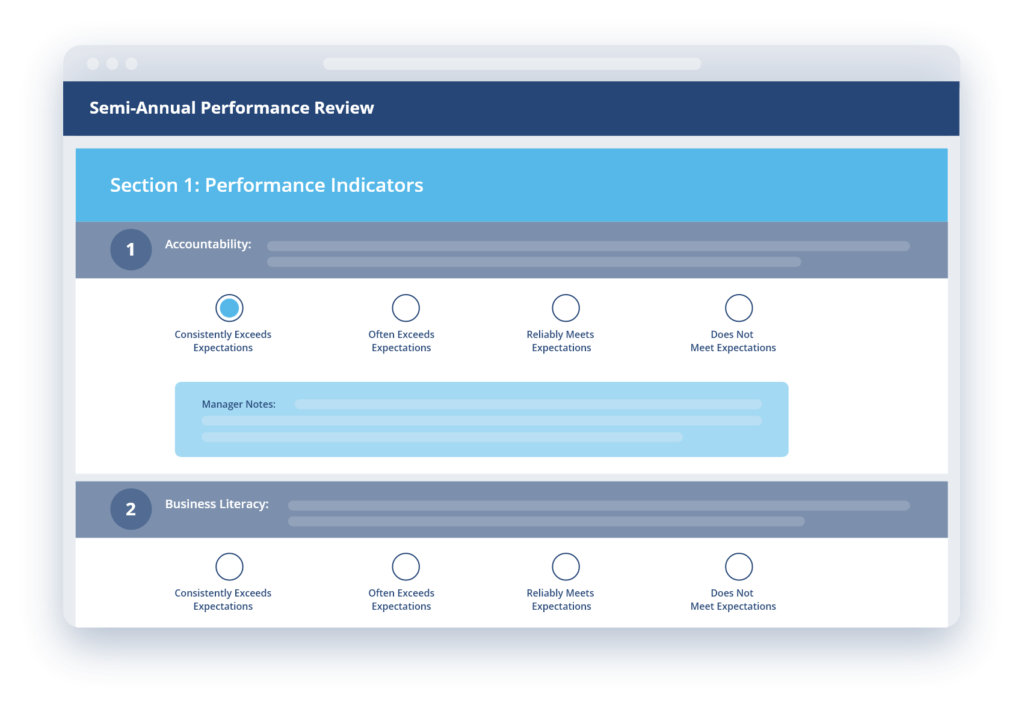
ClearCompany is a talent management suite with ATS, onboarding, performance management, and employee engagement tools, designed with SMBs and mid-market firms in mind.
Top features:
- Mobile-enabled to allow employees to complete reviews on their mobile devices and in their preferred languages
- Allows staff to revisit updates, goal progress, recognition from peers, and more
- Goal-planning tools to create continuous feedback loops, opportunities for problem-solving, and informal coaching
- Customizable review cycles.
Learn to improve your organization’s performance management process
Develop the skills to build a performance management process that helps retain and grow your top performers.
🎓 In AIHR’s Talent Management & Succession Planning Certificate Program, you’ll learn how to:
✅ Create a talent philosophy tailored to your organization’s talent needs
✅ Identify and minimize flight risk to retain crucial talent
✅ Master modern mobility practices to engage and retain staff
✅ Build a culture that aligns individual employee goals with business objectives
Continuous performance management
These platforms structure day-to-day performance with shared agendas for one-on-ones, follow-up tasks and progress logs. This enables regular, documented conversations about goals, blockers and development you can link directly to outcomes.
15. 15Five
- Pricing: $11 per user per month (Perform), or $16 per user per month (Engage, Perform, and the HR Outcomes dashboard).
- Customer rating: 4.6/5 (≈1,800 reviews on G2).
- Suitable for: Small to mid-sized companies.
15Five is a continuous performance and engagement platform that helps you schedule check-ins, one-on-ones, OKRs and feedback to support manager-employee conversations.
Top features:
- Review cycles that include guidance, templates, and customization options
- Integration with all major HRIS systems and productivity tools, such as Slack
- AI-assisted reviews to make writing performance reviews quicker and less biased.
16. Betterworks
- Pricing: Available on request.
- Customer rating: 4.4/5 (≈ 200 reviews on G2).
- Suitable for: Enterprise-level organizations.
Betterworks is an enterprise OKR and performance management platform that links goals, check-ins and reviews to business outcomes.
Top features:
- AI-supported goal alignment
- Calibration that enables managers to easily see all feedback, goals and check-ins, and evaluate performance holistically
- Automated nudges to highlight recognition and enhance engagement.
17. Profit.co
- Pricing: Available on request.
- Customer rating: 4.7/5 (≈500 reviews on G2).
- Suitable for: Companies of any size.
Profit.co is an OKR software that supports strategy execution with goal-setting, task-tracking, and integrated performance reviews.
Top features:
- Comprehensive rating grid that allows HR to assess team performance easily
- Continuous feedback mechanisms to increase employee satisfaction and engagement
- Goal tracking with real-time visibility of performance metrics, supporting an unbiased performance review process.
18. PeopleFluent
- Pricing: Available on request.
- Customer rating: 4.5/5 (based on 32 reviews on G2).
- Suitable for: Mid-sized to enterprise-level organizations.
PeopleFluent is an enterprise talent management suite that focuses on recruiting, performance, and compensation management.
Top features:
- Allows employees and managers to set personalized goals, track progress, and create action plans to achieve those goals
- Feedback request mechanism employees can use any time (e.g., after work milestones, to support their growth
- Lets users build career paths based on current skills and competencies, and set easily trackable developmental goals to boost engagement and retention.
19. Personio
- Pricing: Available on request.
- Customer rating: 4.4/5 (≈700 reviews on G2).
- Suitable for: Mainly small to medium-sized businesses.
Personio is an all-in-one HRIS for SMEs that offers users core HR, payroll, recruiting and performance features.
Top features:
- Cycle-tracker to keep every review cycle on track and nudge people (or yourself) when needed
- Ongoing feedback (including suggestions and kudos) to help employees develop further
- Career frameworks that make people’s next steps clear for everyone involved.
20. Reflektive
- Pricing: Available on request.
- Customer rating: 4.2/5 (≈450 reviews on G2).
- Suitable for: Mid-sized to large organizations.
Reflektive is a performance management solution that prioritizes on real-time feedback, check-ins, and reviews to support continuous improvement.
Top features:
- Reviews, check-ins and conversations focused on growth and development
- Regular, productive one-on-ones to increase employee engagement
- Shared goals and OKRs that align individuals and teams, allow progress tracking, and enable early issue detection.
21. Workleap
- Pricing: $5 per user per month (minimum of 10 users required).
- Customer rating: 4.3/5 (≈1,100 reviews on G2).
- Suitable for: All companies, especially those with a hybrid work system.

Workleap is an employee experience suite (including products like Officevibe) that focuses on engagement, feedback, employee onboarding, and performance rituals.
Top features:
- Self and peer performance evaluations, in addition to manager reviews
- Customizable review cycles and AI-guided performance review writing
- Direct integration with your company’s HRIS.
Performance reviews
The tools below automate the review cycle and consolidate goal data, feedback and notes in one place. This reduces administrative tasks, increases consistency, and shortens the time needed for evaluations, making them more objective, and easier to audit.
22. Leapsome
- Pricing: Available on request.
- Customer rating: 4.8/5 (≈ 2,000 reviews on G2).
- Suitable for: All companies, especially those with a hybrid work system.
Leapsome is a platform that combines performance reviews, OKRs, engagement surveys, and learning paths in one continuous people development system
Top features:
- Seamless integration with your current HR tech stack
- Workflow automations that help you create automated review cycles, including notifications to help people stay on track
- AI-powered reviews and feedback with specific features for HR, managers and employees.
23. BambooHR
- Pricing: Available on request.
- Customer rating: 4.4/5 (≈2,500 reviews on G2).
- Suitable for: Various organization sizes, though its customers are mostly SMEs.
BambooHR is an HRIS (Human Resources information system) that centralizes employee data, time off, onboarding, and basic performance tools on a single platform.
Top features:
- 360-degree feedback to spur your workforce’s growth and development
- Flexible review cycle tailored to each team’s unique needs, as well as pre-built questions and solutions to provide further guidance
- The capability to track one-on-ones and goals in one place.
24. Factorial
- Pricing: Available on request.
- Customer rating: 4.4/5 (≈100 reviews on G2).
- Suitable for: Small to mid-sized companies.
Factorial is an HR platform for small and mid-sized companies that helps users handle core Human Resources, time, payroll, and simple performance processes.
Top features:
- Helps you set performance review periods and define the performance review timeline (including automated reminders for employees to ensure timely completion)
- Factorial AI for performance review summaries and goal alignment
- 360-degree feedback capabilities and one-on-one personalization.
25. EasyPeasy.AI
- Pricing: Free to use.
- Customer rating: 4.5/5 (≈25 reviews on G2).
- Suitable for: Companies of all sizes.
EasyPeasy.AI is an AI performance review and feedback generator that helps managers quickly create structured, objective reviews and improvement plans.
Top features:
- Multilingual support, which is especially useful for managers with international teams
- Ability to generate performance reviews that include essential sections and relevant examples (even when not given detailed data)
- ‘Point of view’ tool that can switch the writing perspective among first, second and third person.
26. Quantum Workplace
- Pricing: Available on request.
- Customer rating: 4.3/5 (≈750 reviews on G2).
- Suitable for: Mid-sized to large companies.
Quantum Workplace is an employee success platform offering engagement surveys, performance reviews, goals, and analytics to support data-driven people decisions.
Top features:
- Customizable employee review software that fits your needs (goal ratings, competencies, questions, etc.)
- Seamless integration of performance reviews into your broader performance management program
- An AI writing and summary assistant to help managers with feedback and to generate suggested actions.
27. AgyleOS
- Pricing: Starts at $8 per user per month.
- Customer rating: Not available
- Suitable for: Organizations of various sizes, since the solution is highly scalable.
AgyleOS is a skills-based talent management platform that offers performance review features, skills matrices, and organizational design tools for modern organizations.
Top features:
- Anonymous feedback that contributes to accurate evaluations of employee competencies
- A skills library that allows you to create a personalized skills map and include favorable skill sets for easy management and monitoring
- Integrated appraisal software and skills gap analysis tool to identify each employee’s competency gaps and areas for improvement.
28. Paycor
- Pricing: Available on request.
- Customer rating: 3.9/5 (≈1,250 reviews on G2).
- Suitable for: Mostly mid-sized companies.
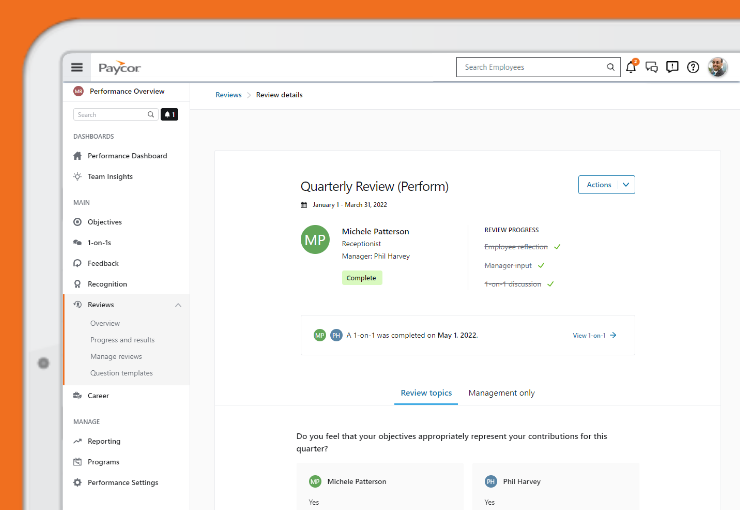
Paycor is a human capital management suite (HCM suite) that combines the management of payroll, Human Resources, and talent on one platform.
Top features:
- Customizable, preloaded templates that enable managers to create coaching sessions tailored to their employees’ needs
- Paycor’s Recognition Tool, which allows employees and managers to highlight outstanding work and acknowledge accomplishments
- AI-driven sentiment analysis driven that helps monitor tone to identify positive, neutral and negative feedback from managers during reviews.
29. Rippling
- Pricing: Available on request.
- Customer rating: 4.8/5 (≈11,000 reviews on G2).
- Suitable for: Fast-scaling SMEs.
Rippling is a unified workforce platform that manages HR, IT, and finance (payroll, devices, apps) from a single system of record.
Top features:
- Customizable performance review cycles and evaluations you can set up in minutes
- Ability to calibrate ratings, promotions and raises
- Allows you to easily assign, share and track employee goals and OKRs across your company.
360-degree feedback
These tools standardize 360-degree feedback by managing rater selection, forms, deadlines and reporting, They also aggregate feedback from different sources into clear summaries for a well-rounded view of strengths and gaps, confidentiality protection, and bias reduction.
30. PerformYard
- Pricing: $5 to $10 per person per month.
- Customer rating: 4.7/5 (≈1,000 reviews on G2).
- Suitable for: Small to mid-sized businesses.
PerformYard is a performance management software that offers flexible review cycles, 360s, goals, and feedback designed to fit different performance philosophies.
Top features:
- Goal check-ins to track progress and course-correct where necessary
- Project-based reviews to provide feedback at the end of a project
- 360 peer reviews and continuous feedback, as well as quarterly conversations, allowing you to run the review process that suits you best.
31. Deel
- Pricing: Starts at $15 per employee per month.
- Customer rating: 4.8/5 (≈11,000 reviews on G2).
- Suitable for: Companies of all sizes, but SMEs in particular.
Deel is a global HR and payroll platform that supports recruitment, payroll, employee and contractor management in multiple countries.
Top features:
- 360-degree performance reviews, goals and feedback all in one system, making it easier to compare them
- Review cycles that launch automatically, with reports, feedback and reminders that sync in real-time
- Dashboard insights that can identify trends and support decision-making.
32. SAP SuccessFactors Performance & Goals
- Pricing: Starts at $18 per user per month.
- Customer rating: 3.9/5 (≈700 reviews on G2).
- Suitable for: Large firms with over 1,000 employees.
SAP SuccessFactors Performance & Goals is an enterprise performance module that aligns objectives, reviews and development with the broader SuccessFactors HCM.
Top features:
- Flexible, continuous performance models that measure team objectives using OKRs linked to individual performance goals
- Feedback in the flow of work with SAP’s and Microsoft Teams’ AI co-pilot, Joule
- 360-degree reviews to assess and rate the skills of peers or employees.
33. ThriveSparrow
- Pricing: Available on request.
- Customer rating: 4.3/5 (13 reviews on G2).
- Suitable for: Small to medium-sized companies.
ThriveSparrow is an employee success and engagement platform with surveys, analytics, recognition and performance tools to build high-performing teams.
Top features:
- Organization-wide 360 feedback reports for individuals, teams, and departments
- A performance trend chart that provides an overview of key competencies, as well as individual and team performance
- Personalized talent maps for every employee, enabling targeted development for the whole workforce.
34. Effy AI
- Pricing: Free for up to five employees, or custom pricing via a calculator on Effy AI’s website.
- Customer rating: 4.9/5 (based on 36 reviews on G2).
- Suitable for: Small businesses (designed for teams of up to 500), but the solution is easily scalable.
Effy AI is an AI-first performance management tool for SMBs that automates reviews, 360 feedback, and summaries to cut admin time.
Top features:
- Easy setup and launch of your first review cycle in less than 10 minutes
- Simple and fast OKR and goal tracking
- Customizable forms, AI-generated reports, and multi-source feedback.
35. Teamflect
- Pricing: $0 per user per month (up to 10 users), then $7 or $11 per user per month (yearly billing), depending on the plan you choose.
- Customer rating: 4.6/5 (≈100 reviews on G2).
- Suitable for: Any organization that uses Microsoft Teams.
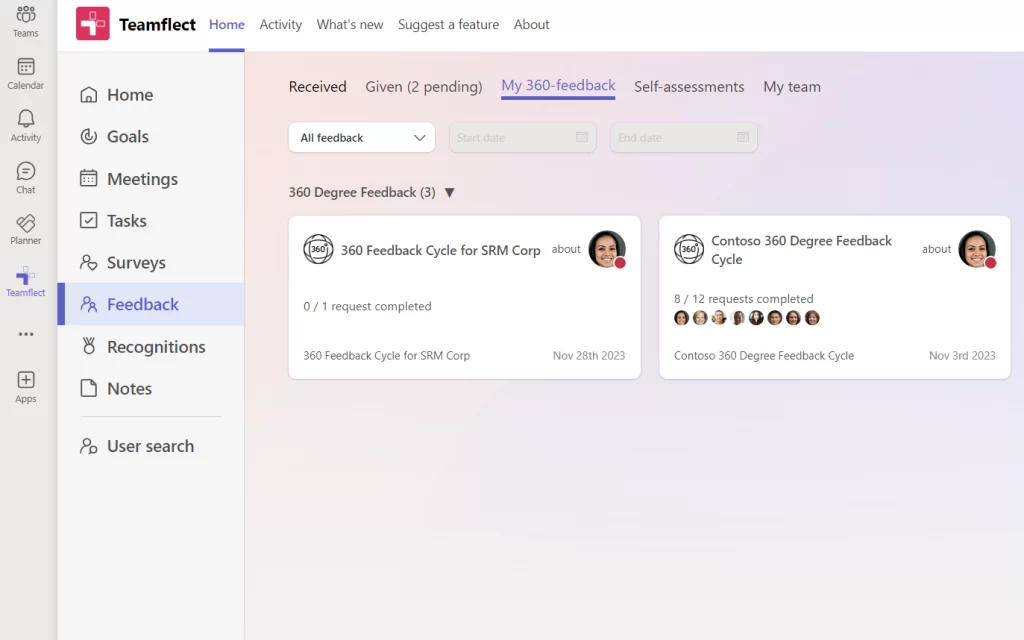
Teamflect is an all-in-one performance and engagement platform built natively for Microsoft Teams and Outlook to run reviews, goals and feedback.
Top features:
- Integrated OKR software that allows you to set and track cascading goals within Microsoft Teams
- Intuitive, customizable performance review templates that help align employee performance with organizational goals
- HRIS integrations to ensure everything works together effortlessly.

8 questions to ask when deciding on the right tool
With so many options to choose from, how do you determine which is the best performance management tool for your organization? Here are eight questions you could ask to narrow down your search:
1. Does the tool/software align with broader business and HR goals?
Suppose one of your company’s business goals is to close employees’ skills gaps to increase productivity. In this case, you may want to opt for a performance management tool that focuses on skills and personalized development.
2. How easy will it be to roll out and adopt?
First, determine if the tool integrates with your organization’s existing HR tech stack. If it doesn’t, ask the provider if they can build a custom integration for you. If they can, ask how long it will take them to do so, then decide whether this is practical for your company and workforce.
3. Will it be scalable as the company grows?
Depending on what stage your company is in, you need to ensure the tool you opt for is easily scalable, both in terms of user number and pricing. You should also assess how suitable it is for a hybrid or remote setup if your company has one.
4. Is it customizable?
While virtually all the tools listed above have this feature, you must still make sure the option you end up choosing not only fits your organization’s performance management framework, but is also customizable. This means it can keep up with any changes your company may make in future.
5. What reporting and analytics capabilities does the tool offer?
While almost all the tools mentioned in this article offer these features, there are often differences in how each one collects and presents data, and from which sources. Look at each one in detail and choose the option that best fits your company’s needs.
6. What AI and automation features does it offer?
Most HR tools for performance management today have AI capabilities. But before selecting one, consider what AI and automation features would benefit your organization the most and fit within your broader AI strategy framework.
7. Does fulfill meet data privacy, security, and AI transparency requirements?
As AI and data regulation continue to evolve, the tools you use must be compliant. Make sure any tool you consider meets these criteria before committing to it. It’s also good practice to ask the vendor how they keep the tool up-to-date and compliant.
8. What kind of post-sales support does the vendor provide?
Does the vendor provide a team or an individual to assist with implementation? Is there a helpdesk you can contact if an issue arises after implementation, or do they only provide email support? Ask these questions before making a decision to ensure you have someone who can help you should any problems arise.
Implementing performance management tools: Top HR tips
Once you’ve decided which tool to use, the next step is implementation. While the vendor you’ve partnered with may guide you through this process, you should still consider the following implementation phases:
Phase 1: Planning and prep
Before implementation, you must set the foundations. Start with policy, then choose the product. Define your performance management philosophy (continuous feedback or annual cycles), how often you set goals (e.g., quarterly), your ratings approach, calibration rules, and how you use performance data in decisions about pay and promotion.
Get stakeholder buy-in early and involve HR, leadership, managers, and employees before you purchase and implement the tool. Clearly communicate “what’s in it for me” — managers save time and make better decisions, and employees gain clarity and personalized growth opportunities.
Then, share the pilot timeline and expectations, so everyone knows what will happen and when. Map your integrations and data flows by identifying the HRIS, LMS, compensation, and collaboration tools you need to connect, and assign clear ownership to support data quality.
Phase 2: Train and enable managers and employees
After setting the foundations, train and enable managers and employees. Start with managers through short, hands-on sessions to build coaching skills, reduce bias, and enhance their ability to provide fair feedback. Additionally, support them with simple checklists, and design simple defaults in the tool (e.g., basic feedback rules) that make the process easy to follow.
At the same time, create enablement assets for everyone — including manager cheat sheets, employee FAQs, email or Slack templates, and a clear review timeline — so people can quickly find answers to their questions and get clarity on what they should do.
Phase 3: Iterate and calibrate
Once you go live, keep iterating and calibrating. Collect feedback from managers and employees, and remove friction wherever you find it (e.g., by simplifying forms or adjusting approval flows that slow managers down).
Validate your analytics and ensure reports display metrics that matter, such as goal progress, performance distribution, and links to business outcomes like sales and turnover. Continue to monitor each review cycle, gather feedback, and adjust your process and configuration to help the performance management system stay relevant and practical.
To sum up
The right performance management tool gives you structure, data, and automation, but does not replace a clear business philosophy or good leadership. Choose a tool that fits your company’s goals, tech stack, and culture — and back it up with strong policies, transparency, and manager training to build trust between employees and managers.
From there, monitor system performance, listen to feedback, and keep refining workflows, analytics, and review cycles. If you treat this as a continuous improvement effort rather thana one-off software rollout, performance management becomes a core engine for better decisions, stronger engagement, and measurable business results.



